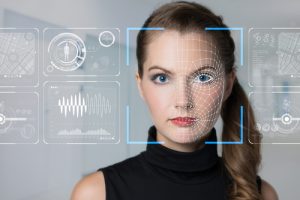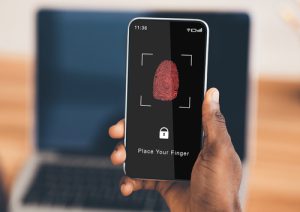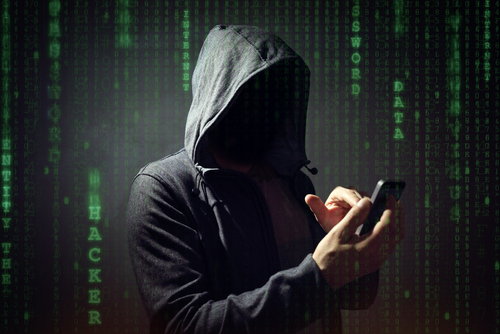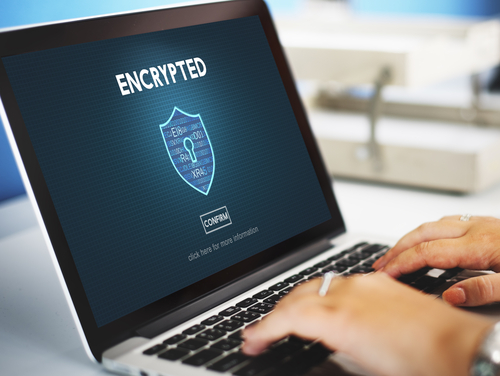Technology changes and grows each day and as it does, there is a greater need to protect our devices, software, and applications by creating and utilizing the latest authentication software.
Biometric authentication is a growing industry that provides users with a way of confirming their identity without the use of passwords, PINs, and passcodes. Face ID and fingerprint recognition are two types of biometric authentication programs mobile devices use to unlock devices and apps.
However, which provides a safer way of authenticating your identity? Read on to learn the pros and cons of both Face ID and fingerprint recognition.

What is Facial Recognition?
Facial recognition is a way of identifying a person’s identity using a live image and comparing it to a photo of the face on file. The software uses a variety of methods to compare the two images and confirm the identity of the user. An algorithm measures the space between facial features.
This can be the space between your eyes or your nose and mouth. Many face recognition scans incorporate 3D image information. When you take the initial scan to put on file, it will ask you to rotate your head in many different directions so that when you try to access the device or account, the program can analyze the live photo for both 3D and 2D information.
These scans can also enhance low-resolution images of individuals from a distance and compare them with high-resolution images. Some facial recognition software uses thermal images of faces and compares the images.
These scans factor out any low-temperature elements such as make-up, glasses, and hats to make an accurate ID.
What is Apple’s Face ID?
Apple’s Face ID is a facial recognition security feature that uses the camera on a smartphone or tablet to create an image of your face in infrared light. Infrared light allows the camera to use iris recognition to read the unique characteristics of a person’s eyes.
The TrueDepth camera creates a depth map of your face, allowing the program to analyze thousands of invisible dots on your face to securely recognize your face data. This program touts being able to adapt to changes in your appearance, such as make-up or facial hair.
Face ID works indoors, outdoors, and in the dark. However, certain camera angles and bright lights may interfere with the camera’s ability to pick up your facial features.
People use Face ID to unlock mobile devices, but it is also popular for social media applications. In 2022, over 131 million Americans used facial recognition daily. Apple is so confident about this technology that all their newest mobile devices utilize Face ID.
What is Fingerprint Recognition?
Each person’s fingerprints are unique. No two people worldwide have the same ridges and lines on their fingers. Fingerprints change very little throughout your life, making them a reliable biometric identification method.
Fingerprint recognition software allows programs, devices, and accounts to confirm an individual’s identity. If a program or device records your fingerprints, the software or device can retrieve this information and compare it to your current fingerprint scan to verify that you are who you claim to be.
Devices use optical, capacitive, ultrasonic, and thermal scanners for this type of biometric authentication. Smartphone cameras use an optical image to capture your fingerprint. TouchID is Apple’s version of fingerprint recognition used on iPhones. You simply place your finger on the home button.
The fingerprint sensor compares your live print to the one stored on your device. If the two are alike, it allows you access to your mobile phone. In 2021, 90% of respondents to a survey about worldwide fingerprint recognition usage said that fingerprint ID is fast and convenient.
Fingerprint recognition software is typically inexpensive to incorporate, and fingerprints are a highly accurate way of verifying someone’s identity. The fingerprint data is stored inside the device itself and not on the cloud. This makes it harder for cybercriminals to access.

How Do People Use Fingerprint Recognition?
Fingerprint recognition has a variety of uses. Many mobile device companies have implemented fingerprints to unlock your phone. Banks and financial institutions can also use fingerprints for access to transactions or to use a digital credit card.
Computers and laptops may have a fingerprint feature that allows only a specific user to unlock the device. Many secure facilities also use fingerprint biometrics to gain access to certain locations. They typically utilize fingerprint recognition devices that people mount to a door or wall.
These devices only allow approved people into a secure location. Some healthcare facilities such as hospitals, pharmacies, and clinics are starting to use fingerprint scanners to match a patient to their records. This can help verify a person is receiving the correct treatment.
In the United States, e-passports contain an electronic chip with biometric data, such as fingerprints that airport security can use to authenticate people. Of course, fingerprint data is stored for the military, border control, and law enforcement to aid in national and local security.
Face ID vs. Fingerprint Recognition
There are many factors to consider when you think about whether Face ID or Fingerprint recognition is safer. There are pros and cons to both security systems. Speed, user-friendliness, and accuracy are some of the most key factors to consider.
Pros and Cons of Face ID
Face ID is faster and promotes a better user experience than fingerprint recognition. People can just hold up their phone, and the camera and software do all the work. There is no need to hold your finger in a particular way.
Facial recognition also works better on smartphones than on laptops. Macs, tablets, and laptops would need more sophisticated cameras and sensor systems to make Face ID viable on these devices. These upgrades would make these devices more expensive.
The Secure Enclave stores Face ID data as a mathematical representation on the device only. So, it is harder for hackers to gain access to this stored scan and use it to access your accounts. However, Face ID may be easier to fake than fingerprint recognition.
Twins or siblings with similar facial features may be able to unlock your devices. Plus, if you are asleep, someone could easily hold up your phone to your face and gain access to your device. People can also use pictures to spoof facial recognition security into believing you are trying to access your device.
Also, the lighting conditions can affect the Face ID recognition. Face ID does not perform well in bright lights. The onset of the pandemic showed another weakness of Face ID—wearing masks. Face ID is becoming increasingly more adaptive, but certain objects can obscure how Face ID identifies you.
Face ID also has a larger margin of error, meaning it may not be as accurate as fingerprint recognition, as well. You can also use a special feature to allow another person to store their facial image on your iOS device to access it as if they are you.
This can be convenient, but it may also make your device less secure. People could use this feature to hack into your device and steal personal data. Criminals can also use Face ID data and conduct reverse image searches. This could allow stalkers to access more data on their victims.
Overall, however, Face ID is an easy and secure way to gain access to a device.
Pros and Cons of Fingerprint Recognition
Apple devices have done away with Touch ID as part of their recognition system. In previous years, the company felt this biometric authentication type would be the future. Once Apple launched the iPhone X in 2017, its Face ID technology became the number one type of biometric identification method, and it continues to dominate the market to date.
Fingerprint recognition takes a second longer to authenticate, making it slightly slower than Face ID. Sweating, wet hands, greasy fingers, dirty hands, gloves, and scars can also make fingerprint authentication harder to use.
This makes Touch ID slightly more inconvenient than Face ID. However, fingerprint recognition is more accurate and more secure than Face ID. Fingerprint scans have a 99.91% accuracy with a much smaller margin for error than Face ID.
Twins and similar siblings cannot gain access to your device because their prints will be different from yours. Only someone with access to an image of your fingerprint or your actual print could get into your device.
There is a strong barrier to gaining this type of information, and it is incredibly difficult for hackers to fake fingerprints. Yet, false positives are still possible. Of course, fingerprint recognition isn’t foolproof, there is always a slight possibility that someone has a close enough fingerprint to yours that they could use to gain access.
Yet, the likelihood of that is much lower than similar facial features.
Which is More Secure Apple’s Face ID vs Samsung’s Face Unlock?
Apple is constantly improving and making its Face ID software better. They have proprietary technology that makes their software adaptive and secure. Android’s Samsung Galaxy Face Unlock has similar features, but it is less secure.
Android facial recognition is prone to more hacks. Face Unlock uses the front-facing camera to scan your face for a matching photo. This means that anyone with a picture of you could easily gain access to your device.
Apple’s Face ID uses sensors and infrared lights to capture a map of your face and compare it to data saved on your device.
Is Face ID Safe for Banking?
Many banks use some form of multi-factor authentication to secure your financial data. Experts consider using a biometric authentication method as being more secure than a PIN or password.
PINs, passcodes, and passwords are vulnerable to brute force attacks, but it is much harder to gain access to facial and fingerprint data. This information is stored on the device, so unless a hacker has direct access to your device, this data is more secure.
Face ID data is encrypted and protected with a key inside the Secure Enclave to keep your face data safe. According to Apple, there is less than a 1 in a million chance that a random person could unlock your iPhone or iPad Pro with Face ID.
Facial recognition systems use verification algorithms to match subjects to their reference images. They score around 99.97% accuracy on standard assessments. So, many banks feel Face ID is a secure way to protect your financial records.
Increase Your Security with Sekur
If you are looking to enhance your device’s security, Sekur can help you regain your privacy. We are a Swiss-hosted, private, and secure email, VPN, and instant messaging service. We use our proprietary HeliX technology to wrap data in 2048-bit encryption with multiple layers.
This makes our encryption many times stronger than others. Plus, our servers are based in Switzerland which boasts some of the strictest privacy laws in the world. You can send encrypted emails to other Sekur users or outside of Sekur with the confidence that your communications will be kept private.
Our instant messenger does not collect or store metadata of any kind. We do not share information with third parties, and we are not connected with any big tech companies. You don’t need to provide your email address or phone number to chat using SekurMessenger.
Our VPN keeps your IP address anonymous online and protects your data with our latest encryption technology. Our Swiss servers have unlimited data and operate at high speeds.
Regain your privacy and try out Sekur today.
Conclusion
Face ID and fingerprint recognition are two authentication methods you can use to access devices, applications, and software. This helps make it harder for hackers to break into your device or account. Both methods have their pros and cons, but both are great methods to protect your personal data.
Fingerprint recognition is a little slower and more temperamental to variability, but it is highly accurate. Face ID is very accurate, but it isn’t 100% foolproof. Face ID is more convenient to use and more widely adopted by smartphone companies.

